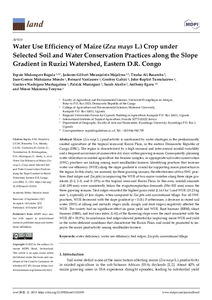| dc.contributor.author | Bagula, E. |
| dc.contributor.author | Majaliwa, J.M. |
| dc.contributor.author | Basamba, T.A. |
| dc.contributor.author | Mondo, J. |
| dc.contributor.author | Vanlauwe, B. |
| dc.contributor.author | Gabiri, G. |
| dc.contributor.author | Tumuhairwe, J.B. |
| dc.contributor.author | Mushagalusa, G. |
| dc.contributor.author | Musinguzi, P. |
| dc.contributor.author | Akello, S. |
| dc.contributor.author | Egeru, A. |
| dc.contributor.author | Tenywa, M. |
| dc.date.accessioned | 2022-12-08T10:01:58Z |
| dc.date.available | 2022-12-08T10:01:58Z |
| dc.date.issued | 2022 |
| dc.identifier.citation | Bagula, E., Majaliwa, J.G., Basamba, T.A., Mondo, J., Vanlauwe, B., Gabiri, G., ... & Tenywa, M. (2022). Water use efficiency of maize (Zea mays L.) crop under selected soil and water conservation practices along the slope gradient in Ruzizi watershed, eastern D.R. Congo. Land, 11(10): 1833,1-21. |
| dc.identifier.issn | 2073-445X |
| dc.identifier.uri | https://hdl.handle.net/20.500.12478/7964 |
| dc.description.abstract | Maize (Zea mays L.) productivity is constrained by water shortages in the predominantly rainfed agriculture of the tropical semi-arid Ruzizi Plain, in the eastern Democratic Republic of Congo (DRC). The region is characterized by a high seasonal and inter-annual rainfall variability and a frequent occurrence of consecutive dry days within growing seasons. Consequently, planning water utilization in rainfed agriculture has become complex, as appropriate soil water conservation (SWC) practices are lacking among most smallholder farmers. Identifying practices that increase water use efficiency (WUE) along the slope gradient is crucial for supporting maize production in the region. In this study, we assessed, for three growing seasons, the effectiveness of two SWC practices (tied ridges and Zai pits) in improving the WUE of two maize varieties along three slope gradients (0–2, 2–8, and 8–15%) in the tropical semi-arid Ruzizi Plain. In this area, rainfall amounts (142–289 mm) were consistently below the evapotranspiration demands (356–533 mm) across the three growing seasons. Tied ridges recorded the highest grain yield (2.16 t ha−1) and WUE (15.23 kg mm−1), especially at low slopes, when compared to Zai pits and conventional tillage. For all SWC practices, WUE decreased with the slope gradient (p < 0.01). Furthermore, a decrease in stored soil water (SWS) at silking and maturity stages (milk, dough, and dent stages) negatively affected the WUE. The variety had no significant effect on grain yield and WUE. Root biomass (RBM), shoot biomass (SBM), and leaf area index (LAI) at the flowering stage were the most associated with the WUE (R2 = 58.5%). In conclusion, tied ridges showed potential for improving maize WUE and yield in the water-deficient conditions that characterize the Ruzizi Plain, and could be promoted to improve the maize productivity among smallholder farmers. |
| dc.description.sponsorship | Carnegie Cooperation of New York |
| dc.description.sponsorship | UK Research and Innovation |
| dc.format.extent | 1-21 |
| dc.language.iso | en |
| dc.subject | Water Use Efficiency |
| dc.subject | Maize |
| dc.subject | Productivity |
| dc.subject | Smallholders |
| dc.subject | Farmers |
| dc.title | Water use efficiency of maize (Zea mays L.) crop under selected soil and water conservation practices along the slope gradient in Ruzizi watershed, eastern D.R. Congo |
| dc.type | Journal Article |
| cg.contributor.crp | Maize |
| cg.contributor.crp | Roots, Tubers and Bananas |
| cg.contributor.affiliation | Université Evangélique en Afrique |
| cg.contributor.affiliation | Makerere University |
| cg.contributor.affiliation | Regional Universities Forum for Capacity Building in Agriculture, Uganda |
| cg.contributor.affiliation | International Institute of Tropical Agriculture |
| cg.contributor.affiliation | Kyambogo University |
| cg.coverage.region | Africa |
| cg.coverage.region | Central Africa |
| cg.coverage.country | Democratic Republic of the Congo |
| cg.coverage.hub | Central Africa Hub |
| cg.researchtheme | Natural Resource Management |
| cg.identifier.bibtexciteid | BAGULA:2022 |
| cg.isijournal | ISI Journal |
| cg.authorship.types | CGIAR and developing country institute |
| cg.iitasubject | Agronomy |
| cg.iitasubject | Biodiversity |
| cg.iitasubject | Food Security |
| cg.iitasubject | Maize |
| cg.iitasubject | Natural Resource Management |
| cg.iitasubject | Plant Breeding |
| cg.iitasubject | Plant Production |
| cg.iitasubject | Smallholder Farmers |
| cg.journal | Land |
| cg.notes | Open Access Article; Published online: 18 Oct 2022 |
| cg.accessibilitystatus | Open Access |
| cg.reviewstatus | Peer Review |
| cg.usagerightslicense | Creative Commons Attribution 4.0 (CC BY 0.0) |
| cg.targetaudience | Scientists |
| cg.identifier.doi | https://dx.doi.org/10.3390/land11101833 |
| cg.iitaauthor.identifier | bernard vanlauwe: 0000-0001-6016-6027 |
| cg.futureupdate.required | No |
| cg.identifier.issue | 10 |
| cg.identifier.volume | 11 |

